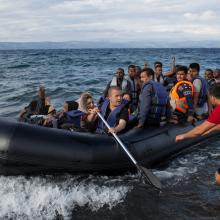Eritrea
A NEW VISION for peace has broken out in the Horn of Africa. For nearly two decades, Ethiopia and Eritrea have been locked in one of the most intractable conflicts in Africa. From 1998 to 2000, nearly 75,000 people on both sides were killed in the war.
That changed in July when Ethiopian Prime Minister Abiy Ahmed and Eritrean President Isaias Afwerki signed a joint declaration of peace and friendship, which ended the war and promised cooperation. Abiy declared, “There is no border between Ethiopia and Eritrea. Instead, we have built a bridge of love.”
The stalled peace process rapidly progressed after Abiy was elected in April. Phone lines have reopened between Eritrea and Ethiopia, and flights between the two neighbors have resumed after 20 years. Families separated by the war are now able to communicate and reunite; many Ethiopians in the diaspora may now return home.
Abiy’s philosophy is that everyone should be included in the peace process. Speaking at a dinner with Eritrean President Afwerki, Abiy defined the idea of medemer (inclusion and multiplicity) in the peace process as “[t]ender love instead of abject cruelty, peace instead of conflict, love over hate, forgiveness over holding grudges, pulling instead of pushing ... Handled wisely, our differences are our assets.”
Abiy’s commitment to an inclusive process is rooted in his doctoral studies at the Institute for Peace and Security in Addis Ababa, where he focused on the role of religious communities in overcoming conflict. Abiy has highlighted the central role religion must play in reconciliation efforts between the two nations.
Ethiopian and Eritrean religious leaders have long worked for peace, even as political solutions lagged. Catholic bishops have asked every parish to offer special prayers and to organize events for peace. Cardinal Berhaneyesus Souraphiel, head of the Ethiopian Catholic Church, commented, “It is very pleasing to the Catholic Church that the prayers of the people of both countries have been answered ... steps taken so far by both governments prove that Africans have the wisdom to solve their problems themselves. The Catholic Church will continue to pray both for Ethiopia and Eritrea.”
Pope Francis met with refugees and leaders of religious faiths including Christians, Jews, Muslims, and Hindus who joined him for a day of prayer for peace in Assisi, home of his namesake, the 12th-century friar St. Francis.
But it was the migrants he invited to join him for lunch on Sept. 20 who captured the headlines and illustrated the tangible impact of war and conflict.

Photo via punghi / Shutterstock
As of May 25, there had been 1,475 deaths since the beginning of the year. By May 30, that number climbed to 2,443 — 968 deaths in just 5 days.
Some officials are attributing this spike to smugglers taking risks with poorer boats as the weather gets nicer.
Sitting outside the central train station here in eastern Sicily, a 16-year-old who would only give his name as “Simon” hunched his knees up to his chest and wrapped himself up into a ball. With little spoken English, the teenager from Eritrea has taken to miming the way he traveled across the Mediterranean.
He was one of around 325 migrants crammed into an overcrowded boat that left Libya earlier this month, only to lose power a few hours into the journey.
In our ongoing coverage of the bovine peace movement: Reuters radio revealed that ambassadorial cows are crossing the highly militarized border between Eritrea and Ethiopia.


